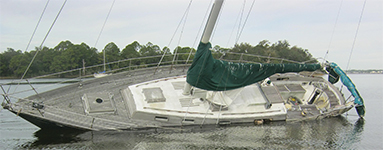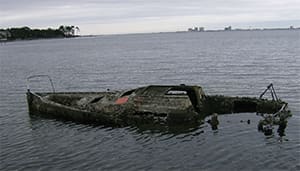To the editor: Florida Statute 327.4107, which took effect July 1, is Florida’s latest attempt to deal with its intractable derelict boat problem.
And the word “problem” here is an understatement: According to a 2011 estimate by the Fish and Wildlife Conservation Commission, Florida’s 1,350 miles of waterways are littered with no less than 1,500 boats that could be considered abandoned, neglected, sunk or in danger of sinking. The Florida Keys alone have 99 boats that fit this description. “We’ve got 366 active derelict cases,” said Phil Horning, FWC’s derelict vessel program administrator. “And that’s just scratching the surface.”
Capt. Jim Suber, dockmaster for the city of Jacksonville who coordinates the removal of derelict vessels is pleased with the statute. “This new law is a great big plus to being able to work with vessels before they actually become derelict,” Suber said. “And that’s a goal that we’ve had locally with the help of FWC officers as well as the Jacksonville Sheriff’s Office.”
Regrettably, these boats and their owners are often lumped together with responsible boaters, cruisers and live-aboards, many of whom anchor as they travel the state. The statute proscribes vessels that are at risk of becoming derelict from anchoring, mooring or occupying the waters of Florida. It defines these as follows:
1. The vessel is taking on or has taken on water without an effective means to dewater.
2. Spaces on the vessel that are designed to be enclosed are incapable of being sealed off, or remain open to the elements for extended periods of time.
3. The vessel has broken loose or is in danger of breaking loose from its anchor.
 |
|
Another wreck still has its mast and sail cover. |
|
Courtesy FWC |
4. The vessel is left or stored aground unattended in such a state that would prevent the vessel from getting underway, is listing due to water intrusion, or is sunk or partially sunk.
Law enforcement officers may now issue noncriminal citations — $50 for the first offense, up to $250 for a third — based on their visual interpretation of the vessel’s state.
This all sounds good, but laws are only effective if they’re enforced. In February 2011, General Order 21 of the FWC empowered law enforcement officers “to remove any derelict vessel … from public waters when that vessel is a hazard to navigation or a threat to the environment.” Additionally, this covered at-risk vessels, which are defined as “a vessel exhibiting conditions known to precede a derelict.”
But the order was not effective in removing or repairing these boats. The FWC website currently lists at-risk or derelict vessels in the following counties: Lee, nine vessels; St. Johns, 10; Franklin, 19; Miami-Dade, 30; Brevard, 46; and Monroe (the Keys), 99! One can only guess the reason for the lax enforcement; perhaps the officers perceive derelicts to be a low priority, or desire to cut these owners a break as they appear to be down on their luck.
Or maybe it’s the cost. When unable to motivate owners to move or repair their boats, local governments must spend $350 to $450 per foot to remove them and often these funds are not available. Whatever the reason, Florida is right back where it started five years ago — its waters littered with more than one derelict per mile, and angry waterfront homeowners who want them all, derelicts and active boaters, to vanish.
To see maps of derelict vessel locations in Florida, visit https://public.myfwc.com/LE/ArrestNet/DerelictVessel/VesselMap.aspx.
—Robert Beringer holds a 50-ton license and works as a college adminstrator.

